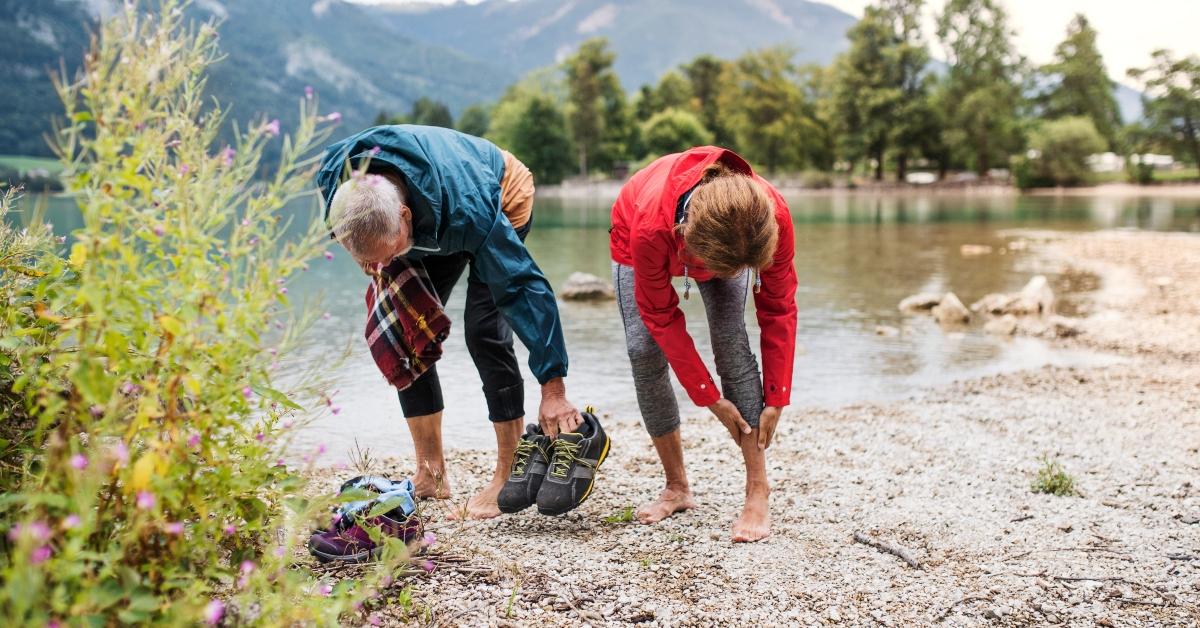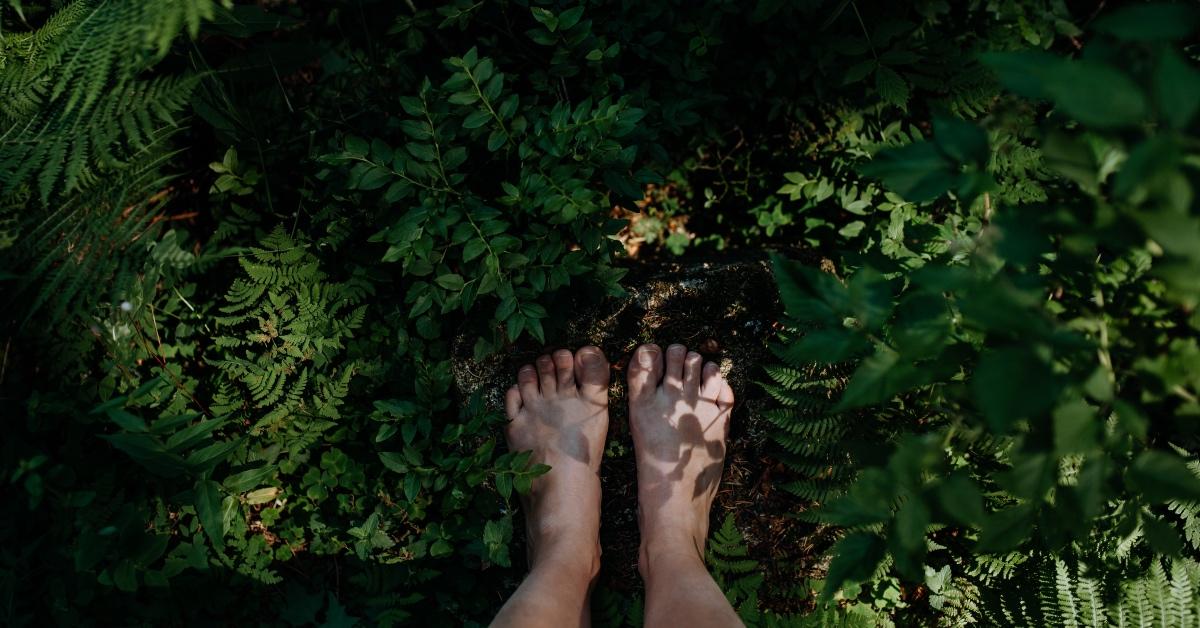Should We All Be “Freeing the Foot”? A Podiatrist and a Barefoot Influencer Discuss Barefooting (Exclusive)
Published Aug. 9 2023, 4:15 p.m. ET

If you're anything like Manhattan dweller Carrie Bradshaw, the "crunchy granola" barefoot lifestyle is foreign to you. For argument's sake, your closet is surely stacked with dozens of Manolo Blahniks and Jimmy Choos, just like that of the shoe-obsessed Sex and the City protagonist.
Even outside of calf-enhancing evening shoes, the world of footwear is highly structured. From ultra-cushioned, shock-absorbing running shoes to chunky orthapedic sandals, most of us are used to having our feet manipulated. Every time we slip on our Birkenstocks (a favorite of podiatrists, hippies, and Barbies everywhere), we tell our feet where to go, how to sit.

So, what happens when we free our tootsies? A growing community of people are encouraging others to ditch the "foot prisons" — as put by Yoshua "the Barefoot Human" Greenfield — and truly connect with the ground.
In an exclusive interview with Green Matters, passionate barefoot influencer Greenfield and board-certified podiatrist Dr. Jodi R. Schoenhaus discussed the positives and negatives of barefoot walking, the anatomy of the foot, and shoe recommendations (both supportive and minimalist). Whether feet gross you out or you're ready for your next pedicure, perhaps it's time you learned a thing or two about your trotters.
What is the meaning of "barefooting"?
The Society for Barefoot Living states that people in the barefoot community "come from all walks of life, across the globe, and simply prefer to go barefoot." Additionally, barefooters "value the comfort, health benefits, and sensory pleasures of barefoot living."
Hilariously, the educational society (which has been around since 1994) firmly states that it does "not discuss sexual or fetish matters."

Barefooting is sometimes connected to "earthing" or "grounding," which Australia's Barefoot Healing describes as a "connection to the Earth's natural energy [via] walking barefoot on grass, sand, dirt, or rock." The site boldly claims earthing practices "can diminish chronic pain, fatigue and other ailments."
The Society for Barefoot Living rejects earthing, calling it a "scientifically unsupported theory." All in all, barefoot living has nothing to do with the so-called healing flow of electrons between Earth and body. It does have to do with the body as a whole, however.
"Your foot is the foundation of your body, everything works its way up from there. If the root of your body isn't stable, if it isn't accounted for, how might that affect everything else?" Yoshua Greenfield — a musician, author, and barefoot influencer with over 100,000 TikTok followers — tells Green Matters. "The more we love on our feet the more we see how much they support the rest of us."
Barefooting is certainly not a 21st-century phenomenon. Though the movement has gained traction thanks to content creators like Sue Regan Kenney, Mara Doemland, and Greenfield, it's kind of been a thing since humans could walk.
"Although it has been around since humans walked upright, it keeps getting more and more popular. For thousands of years, even before the invention of shoes, people walked barefoot. People believe that walking without the support of shoes is a more natural process," Dr. Jodi R. Schoenhaus of Florida's Foot, Ankle & Leg Vein Center says.
We're not exactly born with primal instincts on tying a shoe, so barefooting is the au naturel walking method. But does natural equal better?
Is walking barefoot good for you? Let's talk benefits and risks.
Dr. Schoenhaus explains what happens when a person walks barefoot.
"In a normal or a rectus foot type, walking barefoot allows the small muscles of the foot to become stronger and our feet can 'breathe.'"
This gradual strengthening is what many barefoot enthusiasts are drawn to. Contoured footbeds, plantar orthoses, and arch support don't appeal to those in the barefoot community. Anya, the "Barefoot Shoe Queen," has relied on her bare feet and minimalist shoes for quite a while. She said via Instagram in February 2023 that she has not used arch support in six years.
"A nasty case of tendinitis at the age of 9 landed me in my first pair of orthotics and after that it was supportive shoes year round. I noticed I had discomfort if I ever strayed too far, so I didn't question it," she wrote on her popular barefoot shoe blog, Anya's Reviews. "When I saw my podiatrist as an adult after months of intense foot pain, she reaffirmed this to me and put me in even stiffer, MORE supportive shoes."
She believes her podiatrist's recommendations of structured shoes, custom orthotics, and a cast to "immobilize" her foot are directly connected to her experience with "pain, immobility, and depression."
Hoping to treat her hypermobility and lax connective tissue, Anya decided to "strengthen, stabilize, and rehabilitate" her body, starting with her feet. According to her, ditching arch support, walking barefoot, wearing minimalist shoes, and adding gentle movement to her daily life drastically improved her posture and overall health.
Greenfield, too, "could go on and on" about the benefits of barefoot living.
"Not having to buy shoes, for one, is a great one, or at least drastically cutting down your shoe bill," the Walking Barefoot With Your Best Friend author shares with Green Matters. "My body feels a lot more grounded and connected to the earth, I feel more centered, balanced, my feet don't smell like they did when I wore shoes and socks, [and] my feet look healthy and fresh."
Greenfield personally knows people with a history of back and knee problems. He relays that their pain eventually subsided after transitioning to barefoot living and minimalist footwear.
Still, there is a negative side to this blissfully modest way of living.
Dr. Schoenhaus previously specified that the foot-strengthening benefits of walking barefoot apply to people with "normal" feet.
"Most people do not have a normal foot type. They either have a high-arched, cavus foot, or a flat foot that pronates," she continues. "When we wear a shoe, we allow the shoe to support the sole. People who have flat feet or high arch feet can develop problems as they age. Walking barefoot leads to more strain and impact on the muscles and joints, causing tendinitis, arthritis, and deformity. Thus, in these people, walking barefoot will become a problem over time. For most people, it is recommended to wear supportive shoes and change your shoes frequently."
Though Greenfield is fully committed to the lifestyle, he's also a realist. He knows there are risks involved.
"I live in the mountains and am mostly on trails and land. If you live in a city, it may be more complicated — not impossible, but walking on artificial and flat surfaces isn't as enjoyable as walking on earth," he says.
"There are risks, like stepping on sharp things and hurting your foot. Being barefoot, I am typically more mindful and my foot is so sensitive and hyper-aware that if I go to step on something sharp I notice it immediately. I have thicker calluses that protect from superficial things as well. By the time the glass hits my callus, my foot has been lifted."
If you're going to walk or run barefoot, Dr. Jodi R. Schoenhaus recommends certain surfaces over others.
"The best surface for running barefoot is one that has some shock absorption, such as grass. Running on soft sand on the beach that has no support will cause too much strain on the muscles and joints of the foot. The same applies to running on hard surfaces like pavement, which can lead to knee, hip, and low back pain. In these instances, it is recommended to wear a shoe," Dr. Schoenhaus shares with Green Matters.
"Walking barefoot in the home on carpet is most comfortable, but for people who have tile or marble floors, it can be extremely uncomfortable due to the lack of shock absorption." According to Dr. Schoenhaus, walking and running on surfaces with little shock absorption allows "the impact to get absorbed by the bones and joints of the foot.”
What are minimalist shoes?
Sometimes called "barefoot shoes," minimalist shoes put a thin, barely-there layer between the sole and the ground. These shoes rarely feature any heel and seldom offer arch support.
"When we wear shoes, especially ones with an elevated heel (most shoes), we heel strike when we run, causing lots of pressure to build and tension to run up the back of our legs," Greenfield explains. Some "flats" (think ballerina flats) actually feature tiny heels. Minimalist shoes scrap the minuscule elevation.
Some enclosed minimalist shoes (like boots and sneakers) are even shaped like a foot. As cool as they are, shoes like Converse and Vans squish toes to a point, affecting mobility and comfort.
Everleigh Meadow, Realfoot, and Be Lenka are all brands (approved by Anya) that offer foot-shaped shoes.
Popular minimalist sandal brand Xero Shoes claims its products succeed in "letting your feet do what's natural — bending, flexing, moving, feeling."
"I think the Xero shoe is popular because it provides a layer of protection between your skin and the ground, which can cause skin infections [like] athlete's feet and cellulitis," Dr. Schoenhaus explains.
Greenfield relies on barefoot footwear when he "[goes] somewhere that demands [he] wear a shoe."
"[Xero Shoes'] Genesis sandal is as thin as anything gets and allows my foot to feel open and free. Same goes for Skinners, or similar sock-like protective material," he shares. "This was helpful when I first started getting into off-trail barefoot hiking; if I stepped on a cactus I was protected."
Dr. Schoenhaus believes minimalist shoes mainly benefit the younger population.
"I find that people over 40 have a harder time wearing these shoes for a long period of time, as their feet are not supported enough during activity," she says.
Yoshua Greenfield and Dr. Jodi R. Schoenhaus recommend their favorite shoe brands.
Understandably, Greenfield is skeptical of traditional footwear and mainstream brands, as he feels they "aren't designed with our foot in mind" and favor fashion over function.
"The shoe becomes a foot prison when it is designed for fashion [and] we give the functioning of a foot away to a stiff shoe. Think about how dynamic the foot can be; our arch wants to spring up and down, our toes want to grip. We have more nerve endings on the bottom of our feet than anywhere else, why would we give that up so easily?" he explains.
With this in mind, Greenfield favors a few minimalist shoe brands.
"Xero is popular, they are out by me in Colorado. Luna Sandals people seem to love for being more active. Softstar Shoes has sent me their barefoot style boots, they have a nice handcrafted feel," he shares. Greenfield wears the Softstars when it gets super cold. He also hikes barefoot in the snow, but he "can't recommend it to others."
"People also rave about Vivo Barefoot," he adds.
Dr. Schoenhaus, on the other hand, speaks highly of shoes with added support.
"If you do have a flat foot or a high-arched foot, I often recommend ASICS, Brooks, and HOKA shoes for exercise, and OOFOS for recovery sandals," she says.
The barefoot living experience differs based on several factors: Foot type, age, location, and level of activity. Though Greenfield's internet presence heavily praises barefooting, he's not one to insist one existence is better than another.
"Being barefoot isn't for everyone, but Buddha said something to the effect of, 'Don't take my words on blind faith, come see for yourself,'" he explains. "Think about how many amazing things your hands do, your feet can do just as many amazing things should you let them."